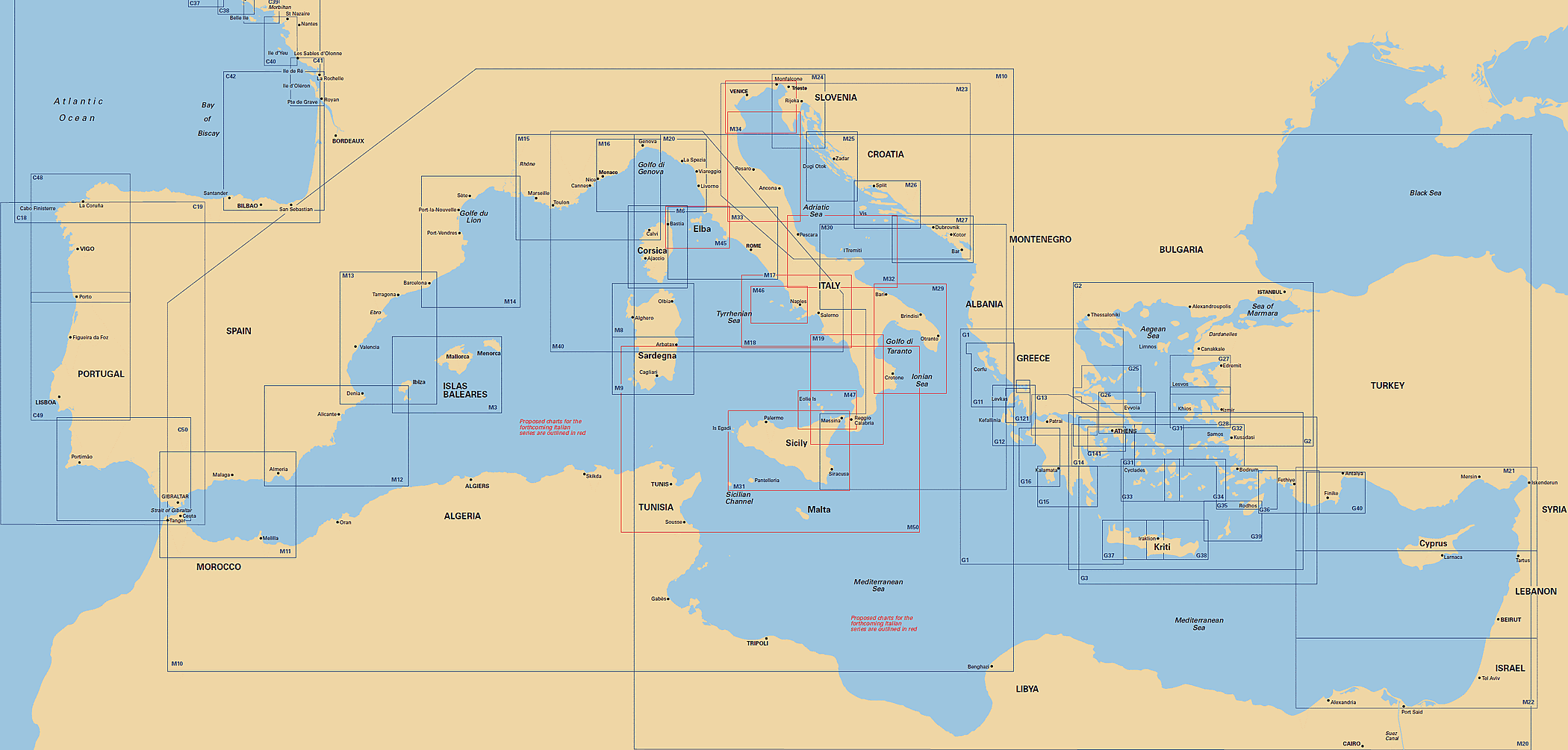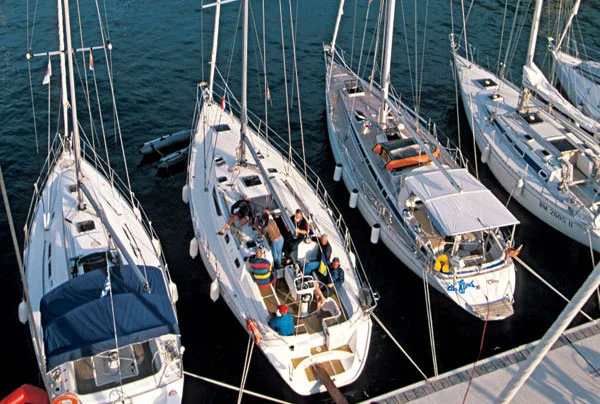Scott and Mary Flanders continue their discussion of cruising the Mediterranean on your own boat. To read their first post, go to http://bit.ly/MedCruising1.
One of our most-asked questions typically comes with folks beating around the bush and dancing with their eyes down: HOW MUCH DOES IT COST??? In 1998, well before our cruising years, Mary and I chartered a rent-a-wreck to cruise the Caledonian Canal across Scotland for a week. There was an American sailboat berthed next to us that had been Out for a while. As I began my rambling, eyes down dance, the lady ended my discomfort by smiling and saying “you spend what you have.” How true it is. Cruisers control their costs as any of you reading this living as ordinary dirt dwellers.
I suppose you picked up on the fact you were just called ordinary. No one wants to think of themselves as plain old boring ordinary. That’s good. Coz when you transition from ordinary to a cruiser, you are no longer ordinary. See where this is going?
If you stay in marinas and eat out regularly, it’s expensive. For some, it doesn’t matter and it makes them happy. For others, it’s a budget killer so they do what they have to do to keep the dream afloat. Neither is wrong or better than the other.
Mediterranean marinas are very different than in the U.S. where dock space is many times more available. Boats ‘Med moor’ in the Med. Marinas in the Med have a heavy chain running parallel to the dock with concrete anchors every so often. Attached to the chain are heavy lines spliced to lighter lines near the dock. These are affectionately (and most of the times, un-affectionately) called slime lines for the slimedog growth that at times includes shells that slice and dice your hands and why you always use gloves when handling slimers.
Here’s the drill. Back in toward the dock. Toss your stern lines to someone on the dock (or on the rare occasion you must jump to the dock) and secure both stern lines with the transom close to the dock. Once the stern lines are attached, nearly always someone will hand you a slime line that you lead forward to the heavier line. Once you reach the heavier line, stuff it through a forward hawse pipe and take three wraps around your de-clutched windlass capstan and hold it tight. Stand on the windlass button up forward and pull the boat off the dock and cleat off the line. Repeat the opposite side slime line. Once both forward lines are secure, adjust the stern and bow lines where you want them with the boat suspended in-between. There is little tide in the Med so if both the forward lines and stern lines are tight it doesn't matter. The lines will stretch with any wake or surge.
There are a couple tricks to Med mooring. The first is practice, practice, practice. Most guys have a problem with that but if you aren’t competent before you reach the Med, it's not a particularly a good place to learn under fire. The easy way to learn before you leave is toss a fender overboard with a line connected to a weight. Practice backing up to the fender in a straight line. Then practice some more until you can do it in some wind.
Another trick to make your life easier is having proper fenders. Most cruisers use a combination of vertical fenders or balls. No good. When you are making contact pushing between boats, vertical and ball fenders ride up. We carried four 1-foot by 6-foot inflatable fenders with lines ending in snap shackles off each end. Each marked fender matched pad eyes on the sides of the boat. Prior to docking we would drift and attach the fenders horizontally along the side below the rub rail. We have literally pushed boats aside on either side making a hole. Med cruisers are used to it and don’t mind...unless you cause damage. Another bit of advice, don’t back faster than you are willing to crash. Throttle jockeys don’t last long before things go very bad, very quickly.
And…you’re not done. You have to get from the boat to the dock so all Med cruisers use a passarelle, or in simpler terms, a gangplank. Passarelles come in hydraulic configurations that cost upwards of $100K to the simple and works-every-time one we made for under $300. We bought a 16-foot, two-piece telescoping fiberglass ladder from Home Depot. We planked each 8-foot side with half-inch marine plywood and bolted it to the ladder. We then brushed on a heavy coat of West System epoxy, and while it was still wet, sprinkled it with heavy beach sand for a nonskid surface. After curing overnight we brushed off the sand, recoated the surfaces with a second coat of epoxy and after another overnight dry, painted it with enamel. A local welder fabricated an aluminum Y that bolted to the inside of the ladder and the short Y portion ended in a piece of pipe that fit into a receiver fitted to the transom cap rail. Lines from the boom raised and lowered the passarelle. The second half of the ladder went to friends who used it during their cruise in the Med that lasted six years. It worked every time. Some folks simply get by with a lightweight 2 x 12 cedar plank wrapped in carpet material. Anyhow you create it, you will need a passarelle of some type to get ashore in a marina.
Our youngest son and his wife on a visit to Barcelona. In the photograph you can see Egret’s home made passarelle and her catamaran dinghy. If the photograph had been taken from a little farther away you would be able to see the entire Med mooring scenario.
The last Med cruising tip we’ll offer is actually universal to any cruising location. Once you get to the Med you will be exploding with enthusiasm. All you can think about is sharing your good fortune with family and friends. There are several truths however. People almost never come. You can't imagine they won’t come, but they don’t. If you remember a while back we mentioned boring ordinary dirt dwellers? "I’d love to, but…" Then comes the excuse. People are so set in their routine, something as wild and crazy as flying to Europe to spend a week or whatever on a boat stretches their comfort level too far. Your gushing enthusiasm doesn’t matter. Isn’t gonna happen.
However, every rare once in a while, someone does show. Burn this into your memory banks: MAKE THEM COME TO YOU, YOU DON’T GO TO THEM!!! Agree on a date but not a place. Getting from an airport in Europe to any seaside destination is easy. I promise, no matter where you are they will be thrilled once they get there. For you it is routine, for them it is way cool exotic. We have cruising friends who spent weeks sitting around one season, twiddling their thumbs, waiting for family members to show up at pre-arranged destinations. Why isn’t this easy? It’s all about weather. To be safe you have to arrive days early to make sure you are there to meet them, particularly during the early or later portion of the cruising season.
To give you a personal example, during 14 years of full time cruising, only once did we have non-family members show up, and even then they were escorting a younger family member. Once in all those years and all those miles, in some of the most interesting locations in the world. Once, and we invited everyone we knew. Once.
I’m still upset about it, not for us coz we were there, but for them and what they missed.
In our next post we will discuss how to get yourself to Europe to begin your cruising adventure.
Scott and Mary













